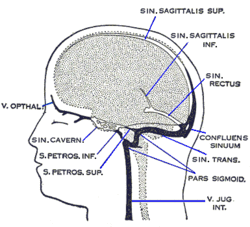
Back دورة دموية دماغية Arabic نەخۆشیی سرەبرۆڤاسکولار CKB Cerebral blodcirkulation Danish Blutversorgung des Gehirns German Circulación cerebral Spanish جریان خون مغزی Persian 대뇌순환 Korean Cerebrale circulatie Dutch Кровоснабжение головного мозга Russian Serebral dolaşım Turkish
| Cerebral circulation | |
|---|---|
 Areas of the brain are supplied by different arteries. The major systems are divided into an anterior circulation (the anterior cerebral artery and middle cerebral artery) and a posterior circulation. | |
 Schematic of veins and venous spaces that drain deoxygenated blood from the brain | |
| Identifiers | |
| MeSH | D002560 |
| Anatomical terminology | |
Cerebral circulation is the movement of blood through a network of cerebral arteries and veins supplying the brain. The rate of cerebral blood flow in an adult human is typically 750 milliliters per minute, or about 15% of cardiac output. Arteries deliver oxygenated blood, glucose and other nutrients to the brain. Veins carry "used or spent" blood back to the heart, to remove carbon dioxide, lactic acid, and other metabolic products. The neurovascular unit regulates cerebral blood flow so that activated neurons can be supplied with energy in the right amount and at the right time.[1] Because the brain would quickly suffer damage from any stoppage in blood supply, the cerebral circulatory system has safeguards including autoregulation of the blood vessels. The failure of these safeguards may result in a stroke. The volume of blood in circulation is called the cerebral blood flow. Sudden intense accelerations change the gravitational forces perceived by bodies and can severely impair cerebral circulation and normal functions to the point of becoming serious life-threatening conditions.
The following description is based on idealized human cerebral circulation. The pattern of circulation and its nomenclature vary between organisms.
© MMXXIII Rich X Search. We shall prevail. All rights reserved. Rich X Search